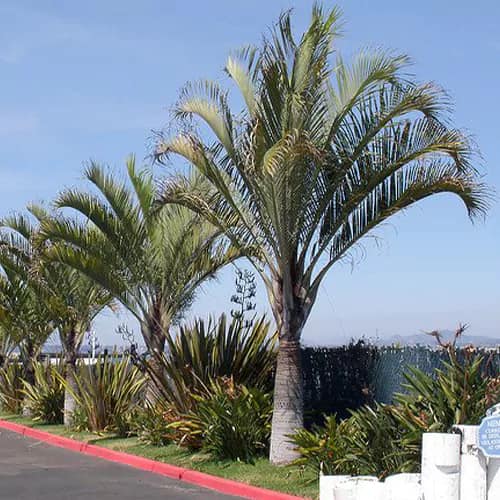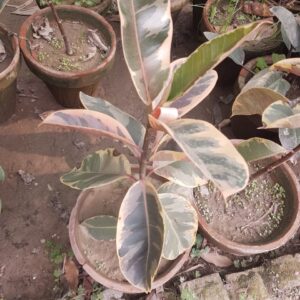Triangular Palm is the tropical world’s architectural masterpiece.
The Triangle Palm (Dypsis decaryi) is one of the most aesthetically beautiful palms, valued for its geometric trunk form and symmetrical fan of silver-green fronds. The Triangle Palm gets its name from the three-sided form created by the overlapping leaf bases around the trunk, which gives it a triangular cross-section, unlike most palms, which have a circular trunk.
This palm, which is indigenous to the arid forests of southern Madagascar, has successfully adjusted to tropical and subtropical environments worldwide. It is an ideal specimen plant for lawns, courtyards, and ornamental gardens due to its slow to moderate growth rate, small size, and sculptural appearance.
🌿 Botanical Overview
Scientific Name: Dypsis decaryi
Triangle Palm, Triangular Palm are typical names.
Family: Palmaceae (Palm family)
Madagascar is the place of origin.
Type: Evergreen palm with a single trunk
Height: 15–25 feet (4.5–7.5 meters)
Range: 10 to 15 feet
Leaves: Feathery (pinnate), lengthy (up to 8 feet), arcing, and with a bluish-green or silver-green hue
Trunk: distinctive triangular arrangement caused by overlapping leaf bases
Flowers: Tiny yellowish-white blooms amidst the fronds
Fruits: Oval, ranging in color from olive to black when ripe.
Requirements for Light and Climate
Sunlight:
Thrives in direct sunshine
Partial shade is acceptable, especially in warmer regions.
Climate:
Ideal for subtropical and tropical climates
USDA Zones: 10–11
Can withstand temperatures as low as -2°C for brief periods of time.
Susceptible to severe frost
Works well in dry tropical areas with ample sunlight, urban gardens, or coastal locations.
💧 Watering Requirements
Early stages (the first 1–2 years) of plant development:
Water every two to three days until established.
Maintain the soil’s moisture content without saturating it with water.
Full-grown trees:
Able to withstand drought
Water heavily once a week during dry months
Water less often during the rainy season
Root rot can be caused by excessive watering or inadequate drainage; always make sure the soil has good drainage.
🌱 Soil Selections
Genre:
Likes sandy or loamy soil that drains well.
Moderately tolerant of soils that are rocky or rich in gravel
pH Range: between neutral and moderately acidic (6.0–7.0)
Perfect for higher elevations or raised beds where water doesn’t accumulate.
Schedule for fertilization
Spring and Summer:
Every three months, feed with a slow-release palm fertilizer that contains magnesium, potassium, and manganese.
Autumn and winter:
Don’t fertilize or only fertilize lightly.
Symptoms of nutritional deficiency include yellowing or fraying of leaf tips, particularly from potassium or magnesium deficiency.
Maintenance and Pruning
Pruning:
Take out solely dead or entirely brown fronds.
As it lowers food output, avoid cutting green fronds.
Taking Care of the Trunk:
Old frond bases are eventually shed by the self-cleaning trunk, revealing the flat, grey surface.
Be careful not to harm the triangular leaf base structure that gives the palm its distinctive appearance.
The process of reproduction
By Seed (Main method):
Gather ripe fruit and harvest the mature black seeds.
Wash and soak seeds in warm water for 24 hours
In warm, humid conditions, germination may occur over a period of six to twelve weeks.
Triangle Palms are not able to be divided because they do not produce pups or offshoots.
🐛 Pests and Diseases
Watch out for the following despite their overall hardiness and resilience:
Insects that scale
Spider mites (in dry climates)
Mealybugs
Rot from fungi (caused by inadequate drainage)
Use insecticidal soap or neem oil, and make sure the air is moving freely.
🌴 Applications and Aesthetics
Perfect For:
In lawns and gardens, highlight or showcase a specimen plant.
contemporary landscape architecture
Pots or containers for young plants
Courtyards, resorts, and entrances
Tip for Designing:
Its architecture may be highlighted by planting it alone, or its symmetry can be emphasized by planting it in triangular clusters.
Use ground covers or ornamental stones for underplanting.
📸 Exotic and extremely photogenic, it makes a statement in every environment.
✅ Conclusion
The Triangle Palm (Dypsis decaryi) is a stunning, sculptural palm that gives any environment a contemporary, tropical feel. Its architectural triangular form, silvery-green fronds, and low water needs make it a fantastic option for urban courtyards, tropical gardens, and minimalist landscapes.
The Triangle Palm is a real work of art in your garden since it is easy to care for, visually stunning, and able to withstand heat and drought.”
Triangle palm
₨2,500.00
“The stunning and unusual Triangle Palm (*Dypsis decaryi*) is a native Malagasy ornamental palm noted for its distinctive triangular trunk shape, which is created by the way its fronds emerge in three orderly rows. Because of this, the palm has its distinctive triangular shape, which makes it stand out in any landscape or garden.
The palm grows at a slow to moderate pace and has hard, erect, bluish-green fronds. It prefers well-drained soil and thrives in direct sunlight or moderate shade. After it is established, Triangle Palm is drought-tolerant and needs very little care. It makes a great specimen plant in tropical and subtropical areas, giving gardens in both residential and business settings an unusual, architectural aesthetic.”





Reviews
There are no reviews yet.